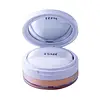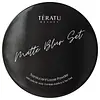What's inside
What's inside
 Key Ingredients
Key Ingredients

 Benefits
Benefits

 Concerns
Concerns

 Ingredients Side-by-side
Ingredients Side-by-side

Talc
AbrasiveDimethicone
EmollientMethicone Crosspolymer
Mica
Cosmetic ColorantTitanium Dioxide
Cosmetic ColorantZinc Oxide
Cosmetic ColorantMethicone
EmollientSilica
AbrasiveCellulose
AbsorbentTriethylhexanoin
MaskingTocopheryl Acetate
AntioxidantTriclosan
PreservativeAscorbyl Tetraisopalmitate
AntioxidantRetinyl Palmitate
Skin ConditioningCI 77492
Cosmetic ColorantCI 77491
Cosmetic ColorantCI 77499
Cosmetic ColorantMethylparaben
PreservativeTalc
AbrasiveAluminum Starch Octenylsuccinate
AbsorbentMethyl Methacrylate Crosspolymer
Hydrated Silica
AbrasiveNylon-12
Diisostearyl Malate
EmollientIsononyl Isononanoate
EmollientSqualane
EmollientPhenoxyethanol
PreservativeCI 77891
Cosmetic ColorantSalicylic Acid
MaskingTocopheryl Acetate
AntioxidantGlycerin
HumectantCI 77492
Cosmetic ColorantButylene Glycol
HumectantEthylhexylglycerin
Skin ConditioningMelaleuca Alternifolia Leaf Oil
AntioxidantWater
Skin ConditioningCI 77491
Cosmetic ColorantCentella Asiatica Leaf Extract
Skin ConditioningRice Bran/Germ Triterpenoids
Skin ConditioningBioflavonoids
Skin ConditioningSesame Amino Acids
HumectantCI 77499
Cosmetic ColorantAluminum Hydroxide
EmollientHydrogen Dimethicone
Triethoxycaprylylsilane
Talc, Aluminum Starch Octenylsuccinate, Methyl Methacrylate Crosspolymer, Hydrated Silica, Nylon-12, Diisostearyl Malate, Isononyl Isononanoate, Squalane, Phenoxyethanol, CI 77891, Salicylic Acid, Tocopheryl Acetate, Glycerin, CI 77492, Butylene Glycol, Ethylhexylglycerin, Melaleuca Alternifolia Leaf Oil, Water, CI 77491, Centella Asiatica Leaf Extract, Rice Bran/Germ Triterpenoids, Bioflavonoids, Sesame Amino Acids, CI 77499, Aluminum Hydroxide, Hydrogen Dimethicone, Triethoxycaprylylsilane
Ingredients Explained
These ingredients are found in both products.
Ingredients higher up in an ingredient list are typically present in a larger amount.
Ci 77491 is also hydrated iron III oxide. It's sole purpose is to give a red/pink hue to products.
Iron III oxides are classified as inorganic chemicals for coloring.
Synthetically created Ci 77491 is considered safer than those naturally found. This is because the synthetically created version may contain less impurities. Iron oxides are generally non-toxic and non-allergenic.
Learn more about CI 77491Ci 77492 is also hydrated iron III oxide. It's sole purpose is to give a yellow hue to products.
Iron III oxides are classified as inorganic chemicals for coloring.
Synthetically created Ci 77492 is considered safer than those naturally found. This is because the synthetically created version may contain less impurities. Iron oxides are generally non-toxic and non-allergenic.
Learn more about CI 77492Ci 77499 is also hydrated iron III oxide. It is created from mixing red and black iron oxides. This helps give shades of darkness to a product.
Iron III oxides are classified as inorganic chemicals for coloring.
Talc is a clay mineral. It helps absorb moisture and improve the texture of products. Like other types of clay, Talc can have a slight exfoliating effect on skin. Talc can be added to increase the volume of products.
Some Baby powders are made by combining talc with corn starch. The word "talc" comes from Latin and originates from Arabic. Talc is a mineral commonly found throughout the world.
If you have any concerns about using talc, we recommend checking out the FDA's official page.
Learn more about TalcTocopheryl Acetate is AKA Vitamin E. It is an antioxidant and protects your skin from free radicals. Free radicals damage the skin by breaking down collagen.
One study found using Tocopheryl Acetate with Vitamin C decreased the number of sunburned cells.
Tocopheryl Acetate is commonly found in both skincare and dietary supplements.
Learn more about Tocopheryl Acetate